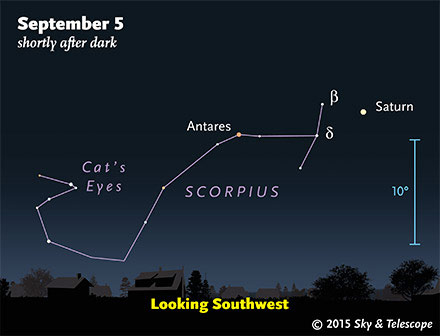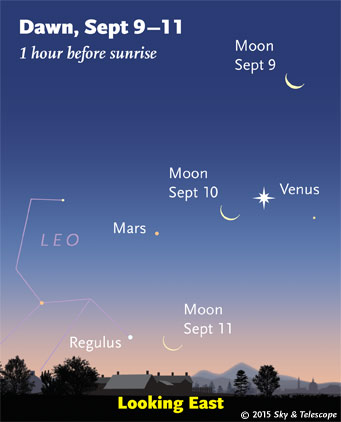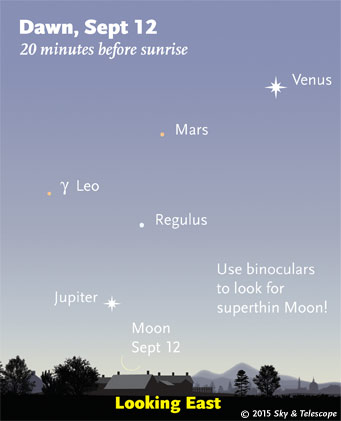
Friday, September 4
• The last-quarter Moon rises around 11 or midnight tonight very close to Aldebaran, depending on your location. The Moon occults Aldebaran soon after rising for parts of eastern North America, and in Saturday's dawn or daylight for Europe and western Asia. See the article in the September Sky & Telescope, page 51. Here are local timetables for the star's disappearance and for its reappearance.
• The Moon is exactly last quarter at 5:54 a.m. Saturday morning Eastern Daylight Time.
Saturday, September 5
• The wide W pattern of Cassiopeia is tilting up in the northeast after dark. Below the W's bottom segment, by a little farther than the segment's length, look for an enhanced spot of the Milky Way's glow (if you have a fairly dark sky). Binoculars will show this to be the Perseus Double Cluster, even through a fair amount of light pollution.
Sunday, September 6
• Sagittarius and the summer Milky Way, rich with deep-sky objects, stand highest on the meridian in the south right after dark this week. Work this area now, before moonlight returns next week. By the time the Moon leaves and we have a dark evening sky again, this area will be past the meridian.
Monday, September 7
• Even though it's not yet autumn, you can already greet Fomalhaut, the 1st-magnitude Autumn Star, twinkling low in the southeast by mid-evening. It shines highest in the south around midnight or 1 a.m.


Tuesday, September 8
• In the dawn of Wednesday the 9th, look for Venus and Mars below the waning crescent Moon in the east, as shown at right.
• And if you're out early enough before sunrise for the stars to still be visible, you get a winter preview! The sky displays the same starry panorama as it will at dusk next February. Orion stands high in the south, Sirius and Canis Major sparkle to its lower left, and Gemini occupies the high east.
Wednesday, September 9
• An hour before sunrise Thursday, look low in the east for the crescent Moon between bright Venus and faint Mars (in the time zones of the Americas).
Thursday, September 10
• Got light pollution? Cygnus overhead offers many sights for small telescopes regardless. See Ken Hewitt-White's "Cygnus in the City" in the September Sky & Telescope, page 58, with chart and photos.
Friday, September 11
• How soon after sunset can you identify the big Summer Triangle? Vega, its brightest star, is nearly straight overhead (for skywatchers at mid-northern latitudes). Deneb is the first bright star to Vega's east-northeast. Altair shines less high in the southeast.
• Thin-Moon challenge: Saturday's dawn offers a chance to try to set your record old-Moon sighting. Look just above the horizon low in the east as dawn grows bright, as shown here. Bring binoculars or a telescope. If you detect the Moon, note the time. Then see how close this is to the time of new Moon: 2:41 a.m. Sunday morning September 13th Eastern Daylight Time (6:41 September 13th UT).
Saturday, September 12
• The Great Square of Pegasus is high in the east after dark, balancing on one corner.
From the Great Square's left corner extends the big line of three stars, running to the lower left, that mark the head, backbone and leg of the constellation Andromeda. (The line of three includes the corner.)
Upper left from the end of this line, you'll find W-shaped Cassiopeia tilting up.
__________________________
Want to become a better astronomer? Learn your way around the constellations. They're the key to locating everything fainter and deeper to hunt with binoculars or a telescope.
This is an outdoor nature hobby. For an easy-to-use constellation guide covering the whole evening sky, use the big monthly map in the center of each issue of Sky & Telescope, the essential guide to astronomy.

Once you get a telescope, to put it to good use you'll need a detailed, large-scale sky atlas (set of charts). The standards are the little Pocket Sky Atlas, which shows stars to magnitude 7.6; the larger and deeper Sky Atlas 2000.0 (stars to magnitude 8.5); and once you know your way around, the even larger Uranometria 2000.0 (stars to magnitude 9.75). And read how to use sky charts with a telescope.
You'll also want a good deep-sky guidebook, such as Sue French's Deep-Sky Wonders collection (which includes its own charts), Sky Atlas 2000.0 Companion by Strong and Sinnott, the bigger Night Sky Observer's Guide by Kepple and Sanner, or the beloved if dated Burnham's Celestial Handbook.
Can a computerized telescope replace charts? Not for beginners, I don't think, and not on mounts and tripods that are less than top-quality mechanically (meaning heavy and expensive). As Terence Dickinson and Alan Dyer say in their Backyard Astronomer's Guide, "A full appreciation of the universe cannot come without developing the skills to find things in the sky and understanding how the sky works. This knowledge comes only by spending time under the stars with star maps in hand."
This Week's Planet Roundup
Mercury (magnitude +0.1) is sinking away very low in the west shortly after sunset. You might still try for it with binoculars or a wide-field telescope down in the murk. Don't confuse it with Spica to its upper left.
Venus (magnitude –4.7) climbs into clearer view in the east every morning. It a telescope it's a beautiful crescent, especially if you follow it rising higher into thinner air after sunrise. Venus is shrinking as it pulls farther away from Earth around the Sun, even as its crescent thickens.
Mars, more than 300 times fainter at magnitude +1.8, is with Venus in the dawn — left of it early in the week, lower left of it later in the week. They're about 10° apart: about a fist-width at arm's length.
Jupiter is still hidden deep in the sunrise.
Saturn (magnitude +0.5, in Libra) shines in the southwest at dusk, to the right of upper Scorpius. Orange Antares, less bright, twinkles 12° to Saturn's left. Between them is the near-vertical line of three fainter stars marking Scorpius's head. (The brightest of these is the middle one, Delta Scorpii.)
Uranus (magnitude +5.7, in Pisces) and Neptune (magnitude +7.8, in Aquarius) are up in the east and southeast, respectively, by 9 or 10 p.m. Finder charts for Uranus and Neptune.
__________________________
All descriptions that relate to your horizon — including the words up, down, right, and left — are written for the world's mid-northern latitudes. Descriptions that also depend on longitude (mainly Moon positions) are for North America.
Eastern Daylight Time (EDT) is Universal Time (UT, UTC, or GMT) minus 4 hours.
__________________________
“This adventure is made possible by generations of searchers strictly adhering to a simple set of rules. Test ideas by experiments and observations. Build on those ideas that pass the test. Reject the ones that fail. Follow the evidence wherever it leads, and question everything. Accept these terms, and the cosmos is yours.”
— Neil deGrasse Tyson
 2
2
Comments
Anantha Krishna -K S
September 7, 2015 at 8:25 am
I am not able to run skychart
You must be logged in to post a comment.
September 9, 2015 at 4:19 am
Perhaps downloading something like Stellarium may be more useful and up to date. It's free and works quite well.
http://www.stellarium.org/
You must be logged in to post a comment.
You must be logged in to post a comment.